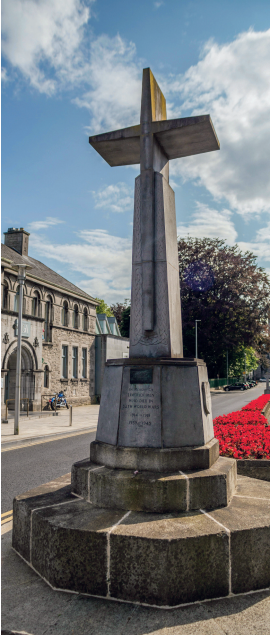Limerick War Memorial
Published in Gems of Architecture, Issue 6 (November/December 2019), Volume 27Pery Square, Limerick
Damian Murphy

Above: The replacement Limerick War Memorial at Pery Square, erected in 1960 after the original, erected in 1929, was blown up in 1957. (Cian Reinhardt)
The number of Limerick casualties in the First World War has been estimated at 3,000, and in 1928 a delegation from the Legion Club went before the Limerick Corporation improvement committee to make the case for a public memorial to be erected at Pery Square. Although permission was granted by a large majority, the idea of a war memorial was not unanimously welcomed by the Corporation; one councillor was reported as saying, ‘They can erect it if they like, but it will come down’.
With the site secured, fund-raising began and advertisements seeking subscriptions were placed in local papers, including one in the Limerick Chronicle of 12 October 1929, where the Legion Club described the proposed memorial as taking the form of a ‘Cross of Sacrifice’, ‘which stands in nearly every War Graves Cemetery throughout the World. A Roll of Honour will be compiled in a bound volume, giving name, rank, unit, where killed, and date …’. By early November almost £360 of the total £550 cost had been raised; by December the deficit was just over £80.
On Sunday 10 November 1929, after separate ceremonies in St John’s and St Mary’s Cathedrals, a procession of ex-servicemen made its way to Pery Square with the Sarsfield Fife and Drum Band for the unveiling of the Limerick War Memorial by Major-Gen. Sir William Bernard Hickie (1865–1950), president of the area council (Southern Ireland) of the British Legion.
An octagonal cross of glimmering white granite, 20ft high and embedded with a bronze longsword, stood on an octagonal plinth inscribed on its centre: ‘TO THE GLORY OF GOD / AND / TO THE MEMORY OF / 3000 OFFICERS / N.C.O.s AND MEN / OF LIMERICK CITY / AND COUNTY / WHO FELL / IN THE GREAT WAR / 1914–1918’. There were further inscriptions on either side. Later an inscription also commemorated the Limerick men lost in the Second World War.
The councillor’s prediction eventually came true on 17 August 1957, however, when the War Memorial was blown up. The Limerick Leader reported that
‘An explosion heard over a wide area of the city about 2.50 o’clock this morning, destroyed the War Memorial … Some people in the vicinity were thrown from their beds by the force of the blast … The cross, shattered by the blast thought to have been caused by a stick of gelignite, was strewn around the severely damaged plinth. In between were portions of the fuse that had been attached to the explosive material. Several windows of buildings in the vicinity were broken by the force of the impact.’
A photograph shows the destroyed memorial, with the longsword, bent out of shape, resting on shattered sections of the cross. An initial claim by the Legion for £3,000 compensation was reduced to £535 and, although challenged by the Corporation, was paid by order of the court.
A replacement memorial, erected on the surviving stepped base, was designed in 1960 by architect Ronald ‘Ronnie’ J. Hickey (d. 2015) of Cratloe, Co. Clare. The new memorial, a stylised reinterpretation of the earlier Cross of Sacrifice, superimposes a streamlined cross on a tapering shaft where low-relief Celtic strapwork alludes to the Early Christian Irish high crosses. A battered octagonal pedestal, clad in limestone panels, carries two inscribed shields and a simplified dedication: IN MEMORY OF / LIMERICK MEN / WHO DIED IN / BOTH WORLD WARS / 1914–1918 / 1939–1945.
Damian Murphy is the Architectural Heritage Officer, National Inventory of Architectural Heritage. Series based on the NIAH’s ‘building of the month’, www.buildingsofireland.com.
















